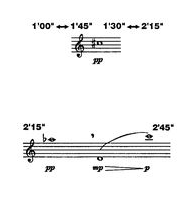Hello LilyPeople,
I am looking into using LilyPond for future works. What I like about it is the text input, which makes it very easy to integrate with the collection of C programs and PostgreSQL functions I use to generate and manage music for large-scale pieces. (I’m on a Mac.)
I have been doing this since the late 1980’s, for John Cage's operas, installations, and films, and for my own large-scale orchestral works, such as “Ocean 1-133” for 150 musician soloists over 90 minutes — see the Merce Cunningham work “Ocean" if you are interested.
The parts for Ocean 1-133 (more than 3000 pages) were pulled from the database and formatted using C code into the P-field file format of the wonderful old Score program by Leland Smith. Like LilyPond, this format is expressed with simple text files. Given the abandonment of Score and the vibrancy of LilyPond, I want to know if I should be using LilyPond.
The example below is from one of Cage’s Number pieces, demonstrating Time Bracket notation. The important challenges for a notation program are:
- Each time bracket is centered on the page, and the system is only as long as necessary.
- No barlines.
- Notes within the time bracket are distributed evenly horizontally. There is no notion of tempo or meter.
- Whole note noteheads - or any notehead I want, free of any metric constraints.
- Ample vertical spacing between time bracket systems.
- Horizontally centered headers and footers (not shown).
- Sometimes one piece runs over several pages (a “piece” is a set of time brackets for one player).

Score had no problem doing this because fundamentally it was a CAD program augmented by musical knowledge. With the P-field format, you essentially cut out the musical knowledge layer. You got to put beautiful-looking music symbols wherever you wanted them. From what I can tell, the musical knowledge part of the equation is too deeply baked in to most notation programs, such that if you don’t need it, or want to invent new rules, you are stuck trying to trick the program into not doing what it “helpfully” insists on doing.
I need to be able to generate 100% of the .ly files from C, taking as a source the composition in the database (which was also generated, using chance operations, with C code). Because of the volume of pages, hand tweaking the parts is not an option.
So:
1. Is LilyPond up to the job?
2. What commands are used to do the time bracket centering, meter-free notehead selection, bar-less notehead equidistant spacing, etc.?
3. Is LilyPond going to gracefully let me set music symbols where I want them, or will I be constantly having to fool it into compliance at every turn? A follow-up question: If I do have to work around LilyPond’s “knowledgeable” music formatting “conveniences”, will these work-arounds end up being “corrected” in future versions, thus breaking my existing code?
BTW, I am open to hiring a knowledgeable LilyPerson as a time-saving and inspirational resource. Reply to this email if you are interested.
Regards,
Andrew Culver